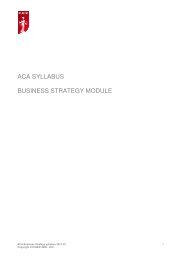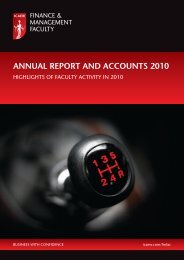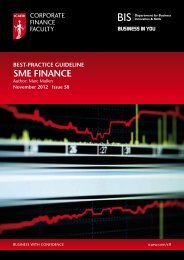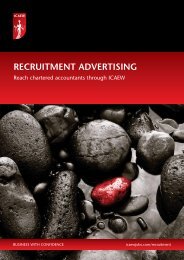Acting in the public interest â a framework for analysis - ICAEW
Acting in the public interest â a framework for analysis - ICAEW
Acting in the public interest â a framework for analysis - ICAEW
- No tags were found...
Create successful ePaper yourself
Turn your PDF publications into a flip-book with our unique Google optimized e-Paper software.
8.1.2 Decision by <strong>in</strong>tuitionMak<strong>in</strong>g decisions by what seems to us as <strong>in</strong>tuition, has also been called ‘fast th<strong>in</strong>k<strong>in</strong>g’. 175 What isactually happen<strong>in</strong>g is that an automatic sub-conscious mental process has been <strong>in</strong>voked whichrecognises patterns, draws on past experiences and which balances various actions and goals(and prejudices) aga<strong>in</strong>st each o<strong>the</strong>r. Thus many of <strong>the</strong> processes considered <strong>in</strong> <strong>the</strong> Bazermanapproach noted above are be<strong>in</strong>g undertaken, but <strong>in</strong> a less structured and objective manner.Decision mak<strong>in</strong>g by <strong>in</strong>tuition can have some advantages: speed; <strong>in</strong>tr<strong>in</strong>sically tak<strong>in</strong>g <strong>in</strong>to accountwhat we really care about; and a greater <strong>in</strong>centive to implementation. 176 It is also a useful shortcut when common sense can be applied and <strong>the</strong> proposed outcome is not go<strong>in</strong>g to be disputed.There is some empirical evidence suggest<strong>in</strong>g that calculation may sometimes be <strong>in</strong>ferior to<strong>in</strong>tuition <strong>in</strong> mak<strong>in</strong>g good judgements. 177 How often do we do an objective assessment, comeup with a ‘best’ answer and <strong>the</strong>n decide that it is not what we really want to do? This maybe because our objective assessment has caused us to focus too much attention on relativelyunimportant criteria, or because we have subconscious learn<strong>in</strong>g processes that can be<strong>in</strong>terfered with by attempts at explicit learn<strong>in</strong>g.However, decision-mak<strong>in</strong>g by <strong>in</strong>tuition also has drawbacks. It is difficult to switch off and <strong>the</strong>past experiences we are draw<strong>in</strong>g on may not actually match <strong>the</strong> current circumstances. 178O<strong>the</strong>r traits of human nature that lead to illogical decisions are considered later. In particular<strong>the</strong>se <strong>in</strong>clude an over-reliance on emotion (or even crav<strong>in</strong>g) and a lesser likelihood of realis<strong>in</strong>gthat <strong>in</strong><strong>for</strong>mation or alternatives are <strong>in</strong>accurate, irrelevant or miss<strong>in</strong>g. In addition, of particularrelevance to this study, it is difficult to demonstrate how <strong>the</strong> process has been applied and isdifficult to apply <strong>in</strong> group situations, where different members of <strong>the</strong> group arrive at different<strong>in</strong>tuitive outcomes.A comb<strong>in</strong>ation of bases – <strong>in</strong><strong>for</strong>med <strong>in</strong>tuition – is considered below.8.2 Bases of overcom<strong>in</strong>g measurement problems8.2.1 MeasurementThe fundamental pr<strong>in</strong>ciple of measur<strong>in</strong>g utility is that that utility is <strong>the</strong> sum of <strong>in</strong>dividual<strong>in</strong>terests. There<strong>for</strong>e one could set out <strong>for</strong>mulae to calculate utility.Panel 8.1: Utility calculation example(a) <strong>for</strong> an <strong>in</strong>dividualr = a1x1 + a2x2 + a3x3 + ……. +/- anx1x2x3….., where• r is <strong>the</strong> overall measure be<strong>in</strong>g maximised (<strong>for</strong> example wellbe<strong>in</strong>g or happ<strong>in</strong>ess);• x1, x2 etc are <strong>the</strong> satisfactions ga<strong>in</strong>ed from <strong>the</strong> different factors that contribute to <strong>the</strong>overall measure (examples be<strong>in</strong>g economic well-be<strong>in</strong>g, health, or safety);• a1, a2 etc are weight<strong>in</strong>g factors applied to each of <strong>the</strong> satisfactions; and• anx1x2x3 is an <strong>in</strong>teractive factor that allows <strong>for</strong> <strong>the</strong> fact that some comb<strong>in</strong>ations offactors may change overall satisfaction <strong>in</strong> a way that is not just <strong>the</strong> sum of <strong>the</strong> parts.(b) <strong>for</strong> <strong>the</strong> <strong>public</strong> <strong>in</strong>terestR = ∑ Yi/Y ri, where• ri is <strong>the</strong> <strong>in</strong>dividual <strong>in</strong>terest <strong>for</strong> each person be<strong>in</strong>g considered; and• Yi/Y is a weight<strong>in</strong>g factor be<strong>in</strong>g allocated to each of those <strong>in</strong>dividuals. 179Like impact <strong>analysis</strong>, <strong>the</strong> <strong>the</strong>ory beh<strong>in</strong>d measurement <strong>in</strong> this manner is relatively easily set outbut <strong>the</strong> underly<strong>in</strong>g concepts are often difficult to quantify.8.2.2 Ends and meansOn <strong>the</strong> face of it utilitarianism is concerned with <strong>the</strong> outcome, so <strong>in</strong>tent is irrelevant. However,<strong>in</strong> terms of decision mak<strong>in</strong>g, utility will often need to be based on expected outcome, <strong>in</strong>which <strong>in</strong>tent may be relevant. 180175Kahneman, Th<strong>in</strong>k<strong>in</strong>g, Fast and Slow.176Thagard, How to Make Decisions: Coherence, Emotion and Practical Inference.177Quoted <strong>in</strong> Thagard, ibid.178Kahneman, Th<strong>in</strong>k<strong>in</strong>g, Fast and Slow.179Desk<strong>in</strong>s, ‘On <strong>the</strong> Nature of <strong>the</strong> Public Interest’.180Schultz, ‘Henry Sidgwick’.Aggregation and decision55
















